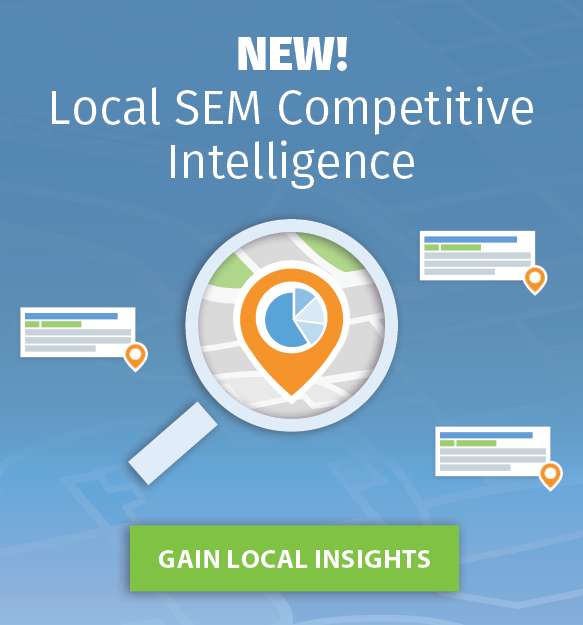
Whether you’re a local small business doing PPC or a regional, national, or international company with a target audience in local markets, you need to know what you’re up against in the paid search results.
And if you’re a PPC agency or consultant, seeing who runs Google Ads (a.k.a Google AdWords) in local areas (and whether they have profitable campaigns) is a key advantage for finding new prospects in your region, and for creating insightful competitor reports that convert your lead into a paying client.
While there are plenty of paid search competitor analysis tools on the market today, only iSpionage enables you to dig into your PPC competitors on a hyper-local level. In this guide, we’ll show you:
- How you can track competitors who are targeting “near me” keywords
- How you can track competitors who are targeting commercial keywords in local areas
- How you can see the SERPs for any keyword in any location on any date
- How you can see the landing pages and full user journey for local PPC competitors
- How you can use local search marketing data to find and secure new prospects for an agency
You’ll learn how to do PPC competitor research on a truly local level, meaning you can see who is winning and losing — and structure your local campaigns to challenge the best in your target area.
How You Can Access Hyper-Local Search Marketing Research
Let’s use the example of a nationwide business doing PPC research on a local market. Say we’re representing Bank of America, and we want to see who is competing for “business bank account” and associated keywords (e.g. “corporate account”) in the thriving economic hub of New York City.
In this case, we know who our competitors are on a national level, but we want to see who is active and profitable in New York’s SERPs. In just a few simple steps, we can set up a project in iSpionage with our list of keywords, competitors, and locations — town, city, region, or country.
You can add multiple locations in one project, perhaps if you’re targeting a city and its various satellite towns — but for the purpose of this example, let’s focus on business banks using PPC to target ‘New York’ customers only.
(Keep in mind: we’ve made all of the images in this post clickable so that you can get a better look at everything.)

Local PPC Competitor Data: What You Need to Know

After letting iSpionage crawl the data on your keywords, competitors, and location(s), you’ll be taken to the ‘Project Summary’ in SEM Campaign Watch, where you’ll see some of the key PPC performance metrics from your list of local competitors. These include:
- Average Impression Share: The average number of impressions each local advertiser has received, divided by the number of impressions that they could have received in total. This metric is used to show whether a PPC advertiser is maximizing their potential — or being outperformed by competitors.
- Average Ad Position: Shows the average position across all the ads for the selected keywords in your chosen geolocation. The higher the figure, the better the campaigns are performing for that target keyword. However, you can have a high average position and a low impression share at the same time — this means that your ad is shown high, but it’s not being shown regularly enough to capture enough impressions. This would suggest you need to adjust bidding strategy or increase your budget to allow your ads to be shown in those high positions more often.
- New Ad Copy & New Landing Pages: Just as the label suggests, this section shows you the number of new ad copy and landing page creatives for each local competitor. You can click through to see these for all the competitors you’re tracking, and understand when they’ve started and stopped different ads. This allows you to monitor the A/B testing process of your competitors — in almost real-time.
Digging Into the PPC Data of Your Local Competitors
In the case of Bank of America, we can see in the below screenshot that they’re being outperformed by Chase, CapitalOne, and MTB in particular, and they’re currently battling it out with Banknovo and Incfile for third place in New York.
The chart below recommends improving impressions, because their average ad position isn’t too bad (3.3). Therefore, tweaks to the bidding strategy, budget, or budget distribution might do enough to get Bank of America up there competing with Chase and CapitalOne.
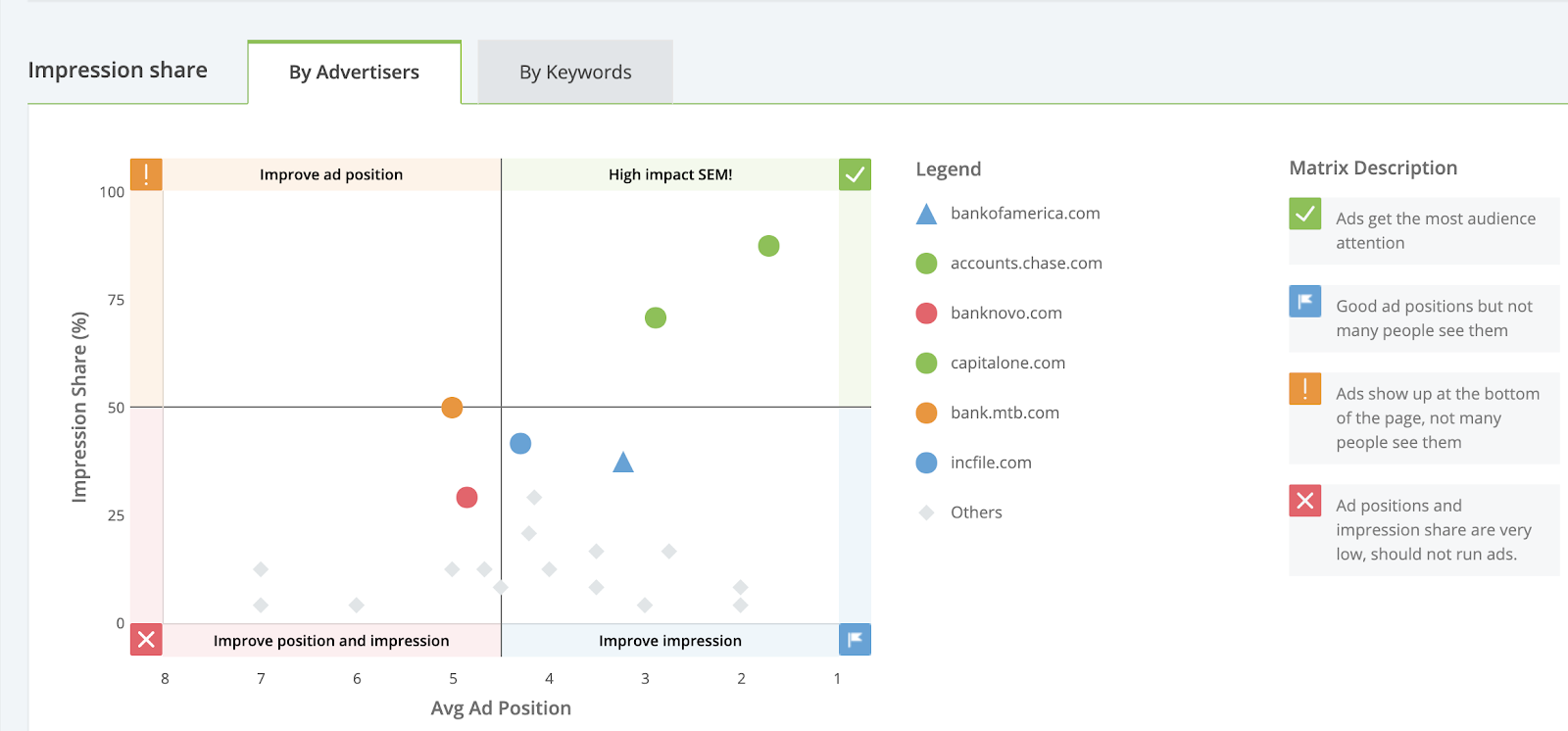
However, it’s worth investigating what Chase is doing in their ad campaigns to gain an 88% average impression share and an average ad position of 1.7. Unfortunately we can’t see their exact spend on the New York geotargeting, but we can dig into their ad creatives. Here, we see that they emphasize a $300 payback to new business account customers. No other advertisers are pushing this sort of offer.

Sign up for a free iSpionage account to see competitor keywords, ad copy, and landing pages. Receive 10 free competitor reports and 3 complimentary competitor alerts per day.
SERP Overview for Keywords, Locations, and Dates
SEM Campaign Watch allows you to monitor the first page of the search engine results for your selected PPC keywords in a specific area — on a certain date.
This is another way for you to stay on top of new competitors, and if you’ve decided to track multiple geolocations in one project (e.g. if you have franchises in New York, San Francisco, and San Diego), you can cycle through them in one dashboard to track each local SERP.
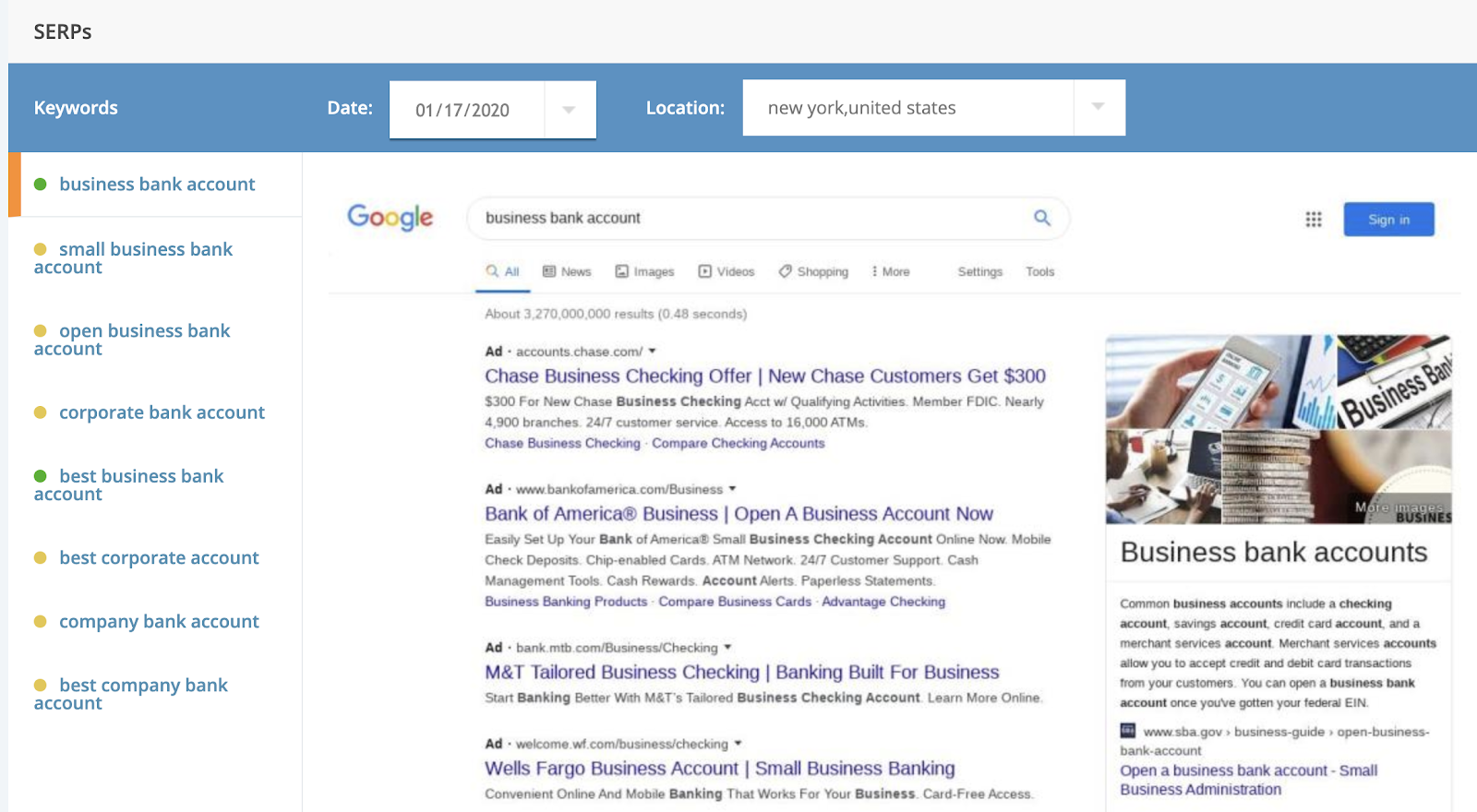
Local Landing Page Insights:
Being able to see landing page designs and local competitor offers is unique to users of iSpionage. No other PPC competitor analysis tool offers this view within the tool, including SpyFu. Landing pages are a critical part of any PPC campaign, because it’s where your competitor converts the user who has clicked.
By seeing the complete user journey from start-to-finish, you can track landing page designs and visuals, match (or beat) offers, and understand how competitor landing pages align with their PPC ad copy.
In the screenshots below, we can see that Chase hasn’t localized any of the messaging in their ads or on their landing page — yet they are the highest-performing PPC advertiser. This would suggest, as we might expect, that the localization of ad creatives for keywords around “business bank account” isn’t common (or necessary) in order to be relevant in target geolocations.


Note: For other niches — such as home services, hospitality, and medical — you are likely to see more variations between creatives: local headlines, local visuals, and local offers.
Sign up for a free iSpionage account to see competitor keywords, ad copy, and landing pages. Receive 10 free competitor reports and 3 complimentary competitor alerts per day.
How to Track Localized “Near Me” PPC Keywords
With the iSpionage SEM Campaign Watch tool, you can track who is competing for variants of “near me” and “nearby” keywords in specific locations. This is particularly useful for local businesses like cafes, restaurants, hotels, and salons — and it also enables marketplaces (e.g. Airbnb) or franchise businesses (e.g. McDonald’s) to research which competitors are running ads in their target locations.
Let’s say I’m the major hotel booking website, Hotels.com. I want to attract people who are searching for “hotel(s) near me” while they’re located in London, UK. So, I need to know what my competitors are doing, who is winning, and how competitors are running profitable PPC campaigns for this keyword.
Go through the same process in Campaign Watch as we showed above:
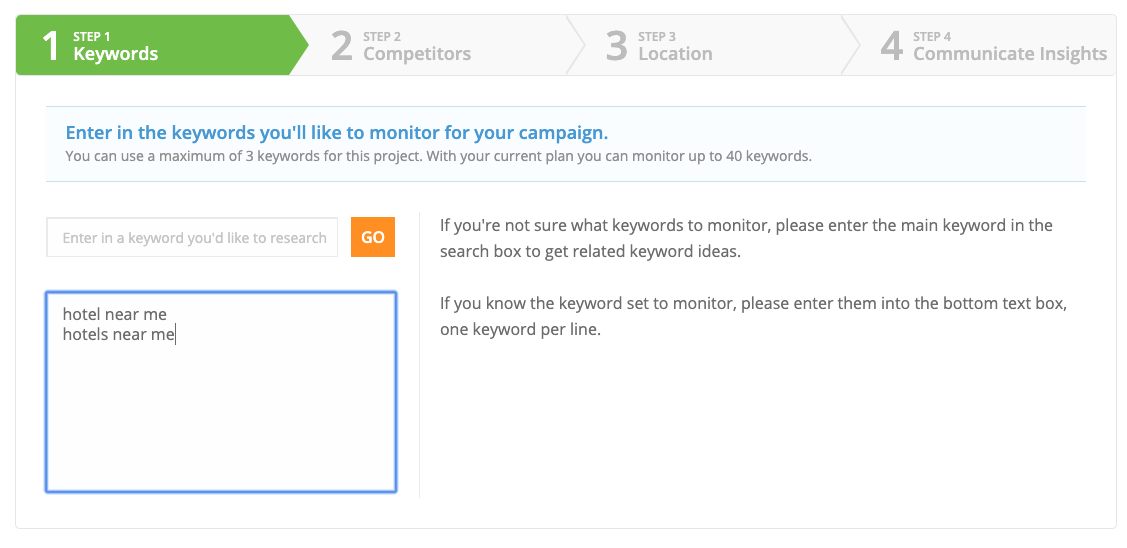
Note: We recommend leaving SEM Campaign Watch to run in the background for at least 24 hours, during which time it will pick up all the PPC competitors in your chosen local area. As an ongoing monitoring tool, the PPC data within Campaign Watch is being regularly updated — so bear this in mind.
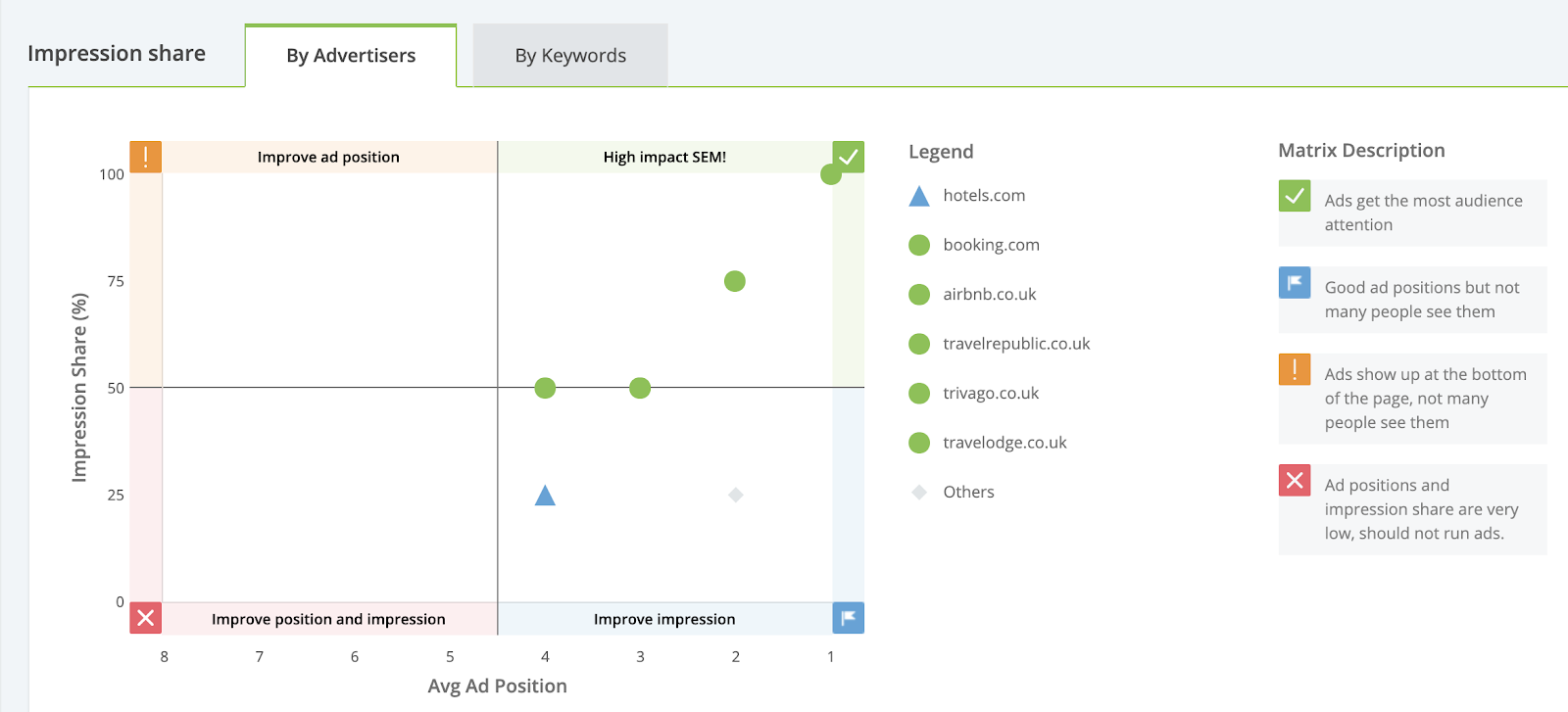
A few things would be interesting to Hotels.com when reviewing their PPC competitors for “hotels near me” keywords in London, UK. Firstly, that Booking.com (top-right corner) is vastly outperforming every other competitor for average impression share and average ad position. They might be putting more budget into their localized PPC campaigns, but not necessarily — because Google actually prioritizes performance, to encourage advertisers to build relevant and compelling ads that get clicked.
So, what could Booking.com be doing to become the highest-performing advertiser in this niche?
In fact, iSpionage shows two things which set Booking.com apart from others in the list: firstly, a very tight alignment between ad copy and search keyword. Secondly — just like the closest challenger Travel Republic — Booking.com has actually used “near me” in the destination URL. Interestingly, Travel Republic chose to include “near you” in their URL — reflecting an answer back at the searcher’s question.
This close ad copy and URL alignment contributes to a good Google Ads Quality Score, and thus will be favoured above less relevant ads for the same keyword. And you can see the A/B testing process, too:
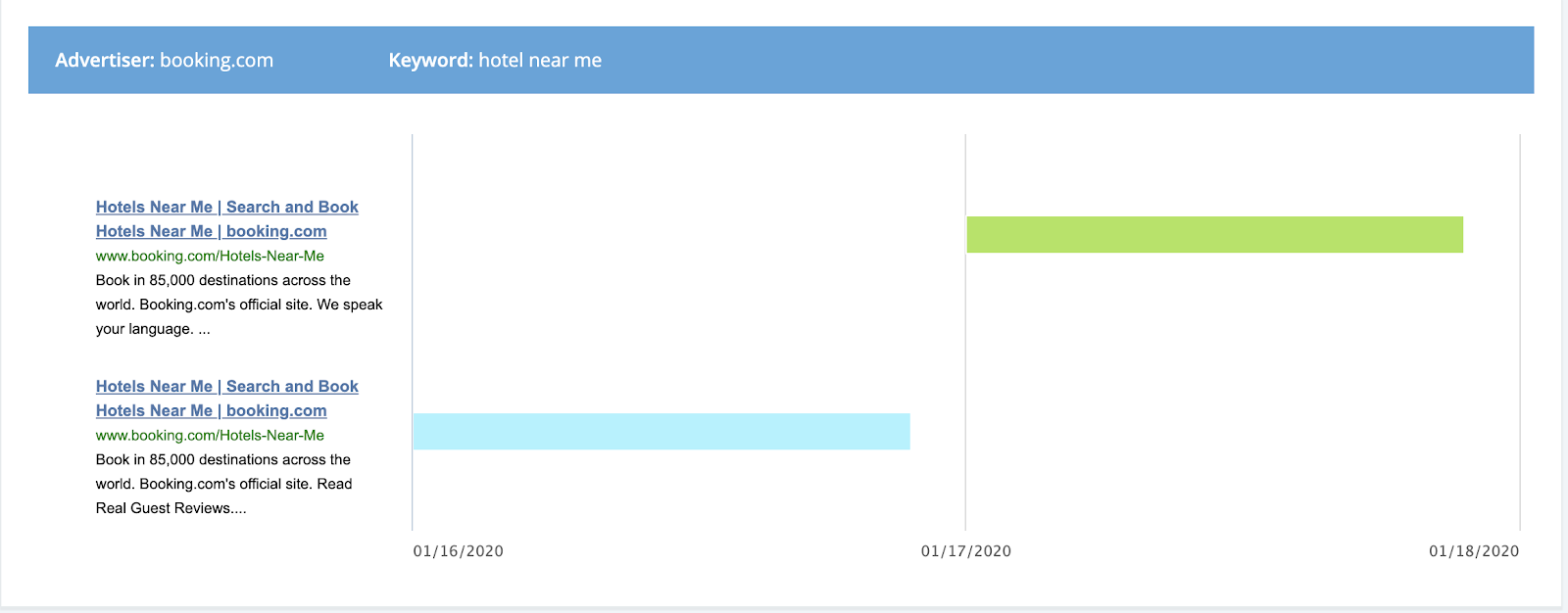
Interestingly, we also see that most competitors for this keyword don’t localize their landing pages. The exception to this is Travelodge, who take a very London-centric approach with ad copy, and direct the user to a page that lists their London hotels. This is different to the tactics of all other PPC competitors, and may reflect the fact that Travelodge is a singular brand of hotels with only 10 premises in London — and thus has a smaller and less complex/confusing inventory to direct the user through to.
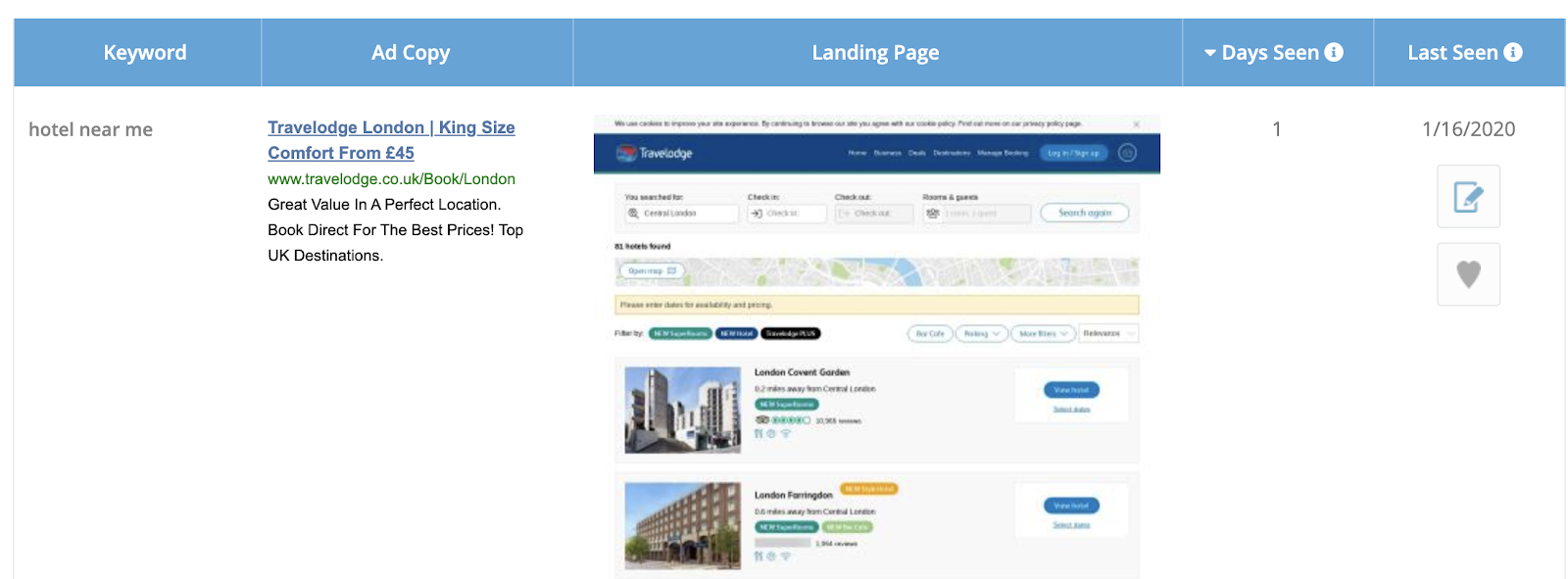
This information is invaluable to PPC marketers, because it shows how your biggest competitors are approaching PPC strategy in their locations. You can see the bigger picture, but also dive into the specifics of each PPC campaign to build an understanding of why each competitor is performing well.
Note: You can also use iSpionage as a tool for your broader digital marketing, because it will track organic search competition as well as your PPC advertising rivals. The Competitor Research function gives a snapshot of the companies who dominate nationwide SEO, and you can use SEO Watch to get local SEO insights. Here, you can track organic rankings and the performance of local competitor content.
How to Get a Quick Snapshot of Localized Keywords
SEM Campaign Watch helps you track the performance and activity of specific competitors over time, and this is where the hyper-local data is available. But you can also use the iSpionage Competitor Research function to get a quick snapshot of who targets localized keywords (e.g. “Attorney New York”).
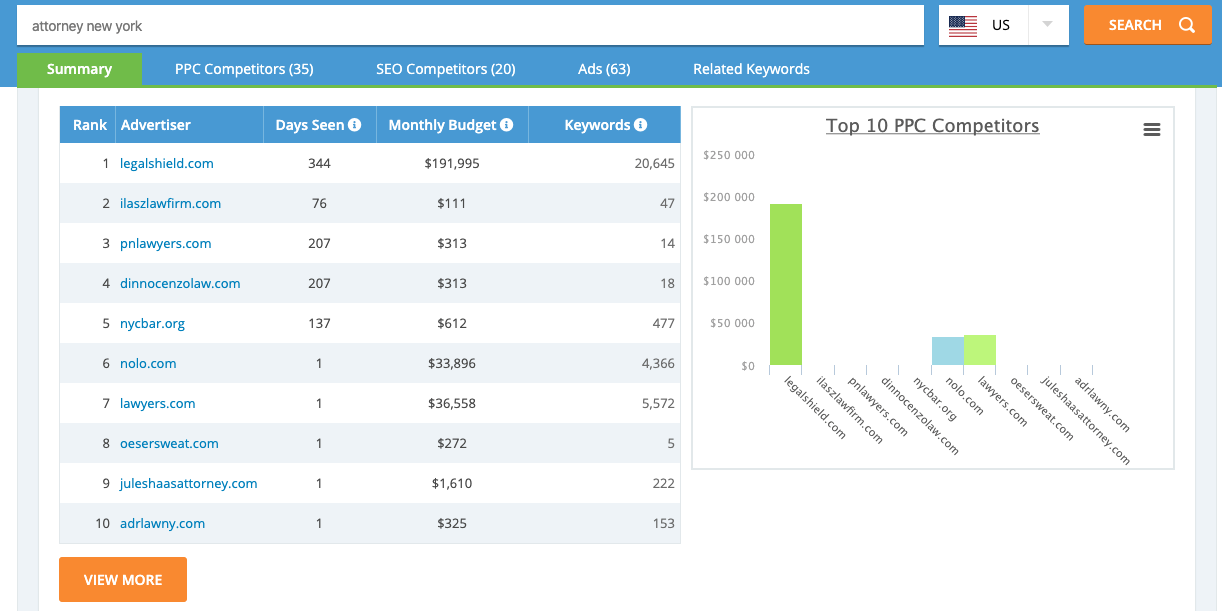
Of course, this isn’t the whole story — because PPC campaigns are often set up to show ads for top-level keywords (e.g. “Attorney”) in specific geolocations. So, we still recommend that you use Campaign Watch for a deeper level of data, but this is also an option for gaining a baseline understanding.
Note: You’ll also find pay-per-click data from Bing Ads & Yahoo! in the Competitor Research area.
Agency & Consultancy Prospecting for Local Clients
If you’re a PPC agency or consultancy working in a specific locality, you can use iSpionage SEM Campaign Watch to uncover potential new customers. For example, you can see which advertisers are underperforming in their niche, which will guide you to cold prospects that could actually use your help.
In this case, you’d come armed with real data to show why they’re losing money and how local competitors are outcompeting them in the SERPs. And for warm prospects who you’re already talking to, this local-level PPC data can help you secure a local customer because you’ll have a really solid game plan — not just the scary numbers, but landing page design recommendations and ad copy ideas, too.
Essentially, PPC agencies and consultants can use SEM Campaign Watch in the same way as a brand would use it — but change the mindset either to supply detailed reports about client/prospect competitors, or to spot which brands are underperforming with their PPC strategy before reaching out.
Key Takeaways: Local Competitor Analysis for PPC Strategy
The devil is in the detail in PPC strategy, and the smallest tweak can make a huge difference to the profitability of a campaign. These local insights — including ad copy and landing pages — help you understand how competitors are approaching local PPC for top-level commercial keywords or “near me” keywords in certain geolocations. This can speed up your learning process, and help you optimize to improve your impression share and ad position — essential parts of a profitable local PPC campaign.
Sign up for a free iSpionage account to see competitor keywords, ad copy, and landing pages. Receive 10 free competitor reports and 3 complimentary competitor alerts per day.
